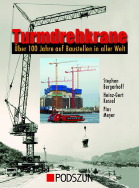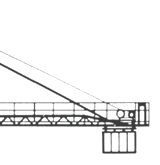
Stephan Bergerhoff / Heinz-Gert Kessel / Pius Meyer:
Turmdrehkrane
über 100 Jahre auf Baustellen in aller Welt
ca. 170 Seiten, ca. 510 Bilder
fester Einband, 28 x 21 cm
EUR 29,90
ISBN 978-3-86133-560-3
Erschienen: 2010
Book review of Dr. Jürgen Schmoll, Durham (GB)
Turmdrehkrane – 100 Jahre auf Baustellen in aller Welt
(Tower cranes – 100 years on sites of the world)
Stephan Bergerhoff, Heinz-Gert Kessel, Pius Meyer
Podszun-Verlag 2010, 166 pages, numerous pictures mostly in colour
German language.
"Finally a book for us !" I thought, being an enthusiast of old tower cranes. I could not wait for the (delayed) delivery of the brand new book. I just know three comparable other books about this subject, of which two are out of print by now.
Traditionally there are various approaches to the topic. A strong historical way from the ancient beginnings to now has not been used here, as the real tower cranes the book deals with did not enter the scene before the last century.
Instead, the book considers the differences in development of this machine type in different parts of the world. So, the “crane culture” in the US is widely different from the European one.
Therefore, after the first chapter dealing in detail with the evolution of the tower crane in Europe, several further sections describe the history and the current state of technology in Australia, the US, China and Japan.
The book finishes with a glossary where technical details of the various crane types are explained. This is a good jargon buster where the reader learns what elephant feet are when it comes to cranes.
The 1st chapter covers 106 pages. Being the largest part of the book, it describes the European evolution of tower crane development. This is characterised by several stages of evolution from the luffing to the trolley jib, from heavily built machinery to the modern fast-erecting crane. It is obvious that the transistions between different crane architectures are smooth and not straightforward at all. There were always particular late or particular early specimen of one type entering the crane market.
In particular the embedded stories of cranes in action are entertaining. So for example a tower crane used at a running power plant is mentioned where the burden for the machine and it’s operators was rather tough due to the sulphuric fumes hitting the crane and entering it’s cabin. Another of this inserts deals with the world largest tower crane, the Kroll K-10000, and even larger types that never left the drawing board. A tree-like diagram at the end tries to summarise the tower crane evolution in a nice graphic way.
The further chapters about the crane development in other countries are very interesting to read as well. They show up completely different concepts caused by different conditions. So the Australian Favco cranes produce their own electricity by a Diesel generator at their top platform, while the US was very hesitating and sceptical about tower cranes at all. However, in situations as the construction of the World Trade Center in New York the superiority of the tower crane (that became imported from Australia) became convincing. The reader learns that in China – apart from the notorious habit of copying – new problems gave rise to new solutions, for example for the erection of 200m tall power pylons. In Japan a tower crane is a high tech product that not only warns the operator in case of an earthquake, but actively compensates seismic movements by actuators located in the tower. While the crane output of Japanese manufacturers is considerably lower than in Europe, they are top notch in terms of safety, precision and comfort.
To summarise, I can recommend this book to all crane lovers by 100 percent. The good craftmanship (high quality paper, well bound), the competent knowledge and the extremely large pool of images make the book an evening filling pursuit. My verdict hence: 10 out of 10 points !
Please note the language of this book is German. While the images are of large interest for non-german readers as well, an English translation is currently not available.


